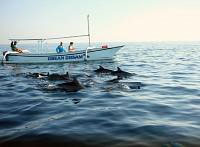JOGJAKARTA CENTRAL JAVA
Vredeburg Fort and Gedung Agung
At the end of this "bouquet" street, tourists can drop by at Vredeburg Fort that is located across Gedung Agung. This fort was the Dutch protection basis from possible attacks by Yogyakarta Kingdom troops. Similar to other forts, this place built in 1765 is high, square walls confining the area inside with one monitoring tower in each of the four corners for patrolling purpose. From the tower at the southern part,You took the opportunity to enjoy sceneries of the Sultan Palace and other historical buildings.
Malioboro Cross-Legged Food Vendors (Lesehan, Javanese Language)
When the sun sets in the west and at the same time the lights along the street and the arcade add more beauty to Malioboro, food sellers begin to set the cross-legged eating place. Special menu of Jogja such as Gudeg and Pecel Lele are served in addition to oriental cuisines and sea food as well as Padang cuisine of West Sumatra. The street singers will sing hit songs and memory songs for some small change.
For tourists who are going to try menus served along Malioboro Street, please do not hesitate to check the price list and confirm it to the seller to prevent illogical charge.
Visiting Yogyakarta, the city known as "The Javanese Culture Living Museum" will not be complete unless you pay a visit to the street that keeps various stories of Indonesian Nation struggle and crowded with various souvenirs. It is paradise for history lovers and souvenirs hunters.
Taman Sari Water Castle
Formerly Tamansari was a recreation garden or a resting house for the Sultan and Family. The other resting houses including Warungboto, Manukberi, Ambarbingun, and Ambarrukmo functioned for the vacation and meditation for the royal family. The other function is used as hiding place for royal family to defend against the enemy assault.
Tamansari is located about 2 km south of Yogyakarta Palace. Built by Portuguese architect in European aquatic construction adorned with Javanese Symbolize ornaments. Tamansari was built in the Sultan Hamengku Buwono I period in the end of XVII Century. Tamansari not only just a recreation, but it's also a compound of bathing pool, canals, rooms and extremerly large swimming pool (if the canals opened).
The Tamansari complex consist of:
-
The Sacred Room
There is the sacred place in the complex showing a separated building, which once functioned as a hermitage place for the Sultan and his family
-
The Bathing Pool
This part was formerly a pleasure place for the royal family. Consists of two bathing pool that are separated with a 2-storey building. From this building the Sultan watched all the women swimming in the outer pool. Then he might ask some of them to accompany him into the inner pool. The water sprouts from a forming animal statue into the pool. The pool is also adorned with some big flowerpot.
-
Kenanga or Cemeti Island
This part compounds of some building such as Kenanga or Cemeti Island (forming Island), Sumur Gemuling and underground tunnels.
This artificial island is a high building used as resting room and reconnoitering place. This will be the only building surfaced when the canals opened and the water over flew this area. From the higher place it like lotus floating in the middle of big pool.
Sumur Gemuling is building constructed in circle such a well (Javanese: sumur) where some rooms formerly used as praying room.
The tunnels in this area were underground passageways to the Sultan palace. The legend says about secret tunnel connecting to the south sea (Indian Ocean) where Nyai Roro Kidul or the Queen of the South has her palace. The supernatural Queen becomes the wife of Yogyakarta Sultan for many generations. This secret tunnels is gateway to the world where the Sultan meeting is supernatural wife. However the building also functioned as a hiding place for the royal family against the enemy attack.
Tamansari is an interesting place to visit. Besides the location is very closed to the Sultan palace, Tamansari has it owned speciality in attraction reflecting in some unimpaired ancient building and its atmosphere as the main tourist object of Yogyakarta.
There is Masjid Sokotunggal, a unique mosque with a single pillar that is different from Javanese traditional architecture. Although built in the early of XX century, the mosque gives another attraction of this area. Kampung Taman that lies in the Tamansari complex nearby known for the batik craft. Visitor can buy or watch handmade process for both batik painting and batik clothes. Therefore people from all over Indonesia and abroad have visited this village. Not for from Tamansari is Ngasem traditional market, the biggest bird market in Yogyakarta. All of those attractions have made Tamansari become one of main tourist object in Yogyakarta besides Yogyakarta palace.
Keraton Sultan Pallace.
Kraton or Keraton is the Javanese word for a royal palace. Its name is derived from ratu, which means "ruler" (king or queen). In Java, the palace of a prince is called puro or dalem. The general word to designate a palace is
istana, as in Indonesian and Malay.
The locations of former kraton has been determined by historical records or archaeological efforts. Former kraton include:
Kraton Ratu Boko , east of Yogyakarta in the Prambanan area. The structure dates from 9th century and is thought to belongthe Sailendra or Mataram Kingdom, however local inhabitants named this site after King Boko, the legendary king in Loro Jongrang folklore.
Kraton of Majapahit in Trowulan, Mojokerto, the capital of the former Majapahit. Sites such as Pendopo Agung Majapahit are thought to be remnants of the Kraton of Majapahit.
In Banten region there are remnants of the Sultanate of Banten's palaces:
Kraton Surosowan, Banten, former royal palace of Sultanate of Banten
Kraton Kaibon, the former palace of queen mother
In Yogyakarta and Surakarta region, there is the remnants of Sultanate of Mataram palaces:
-
Kota Gede remains of a palace from the 16th century.
-
Karta and Plered, there are remains of palaces from the 17th century
-
Kraton Kartasura on the outskirt of Surakarta, remains of palace and city wall, also dated from 17th century
The term kraton 'palace' is also used as a way to refer to the court which it houses.
This is especially the case for native Indonesian states where the succession is disputed, giving issue to two or more branches of the dynasty, or even rivaling dynasties, each setting up an alternative court, while competing for the same state, but generally only controlling part of it.
An example is the West-Javan state of Cirebon, which was founded in 1478 and since 1662 was ruled from four kraton (palaces):
-
Kraton Kasepuhan, using as the ruler's style Sultan
-
Kraton Kanoman, style Sultan
-
Kraton Kaprabonan, style Panembahan (lower in rank)
-
Kraton Kacirebonan, style Sultan
JOGJAKARTA HERITAGE INTERESTING TO VISIT















